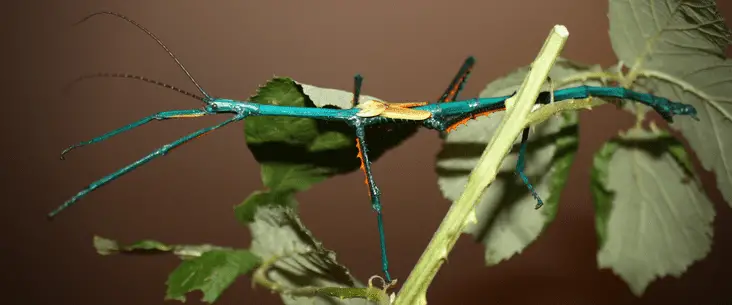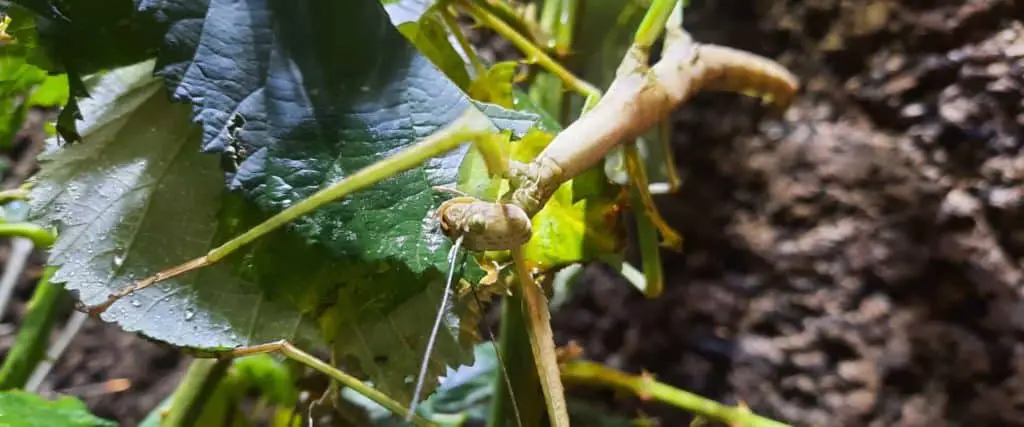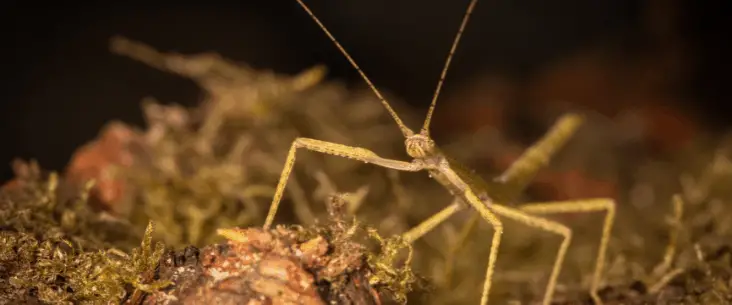Are you considering a stick insect as a pet? Stick insects are great pets to keep. Although they suffered from a reputation of being boring, they are actually amazing pets to have. But there is more to stick insects than only the “general” thought of being motionless, resting and sitting on a branch. But how many stick insects are there? And which one should you choose?
There are over 3000 species of stick insects described today, and around 300 species have been kept and reared in captivity as pets. Stick insects can be roughly divided into three categories: Thin-bodied stick insects, thick-bodied stick insects and leaf insects. When we talk about all stick insects, they are generally referred to as phasmids, phasmatodeans or ghost insects.
We will have a closer look at different types of stick insects and discuss the most popular species that are kept as pets. In the end, you will see that stick insects are all but boring. Let’s dive into the world of stick insects!
Popular thin-bodied stick insects
Thin-bodied stick insects have the classic and typical look of stick insects, also referred to as walking sticks. The body is quite thin and is not much thicker than the legs. Don’t think they are just that boring green stick that sitting still all day. Some are quite colourful. Let’s have a look at the more popular thin-bodied stick insects.
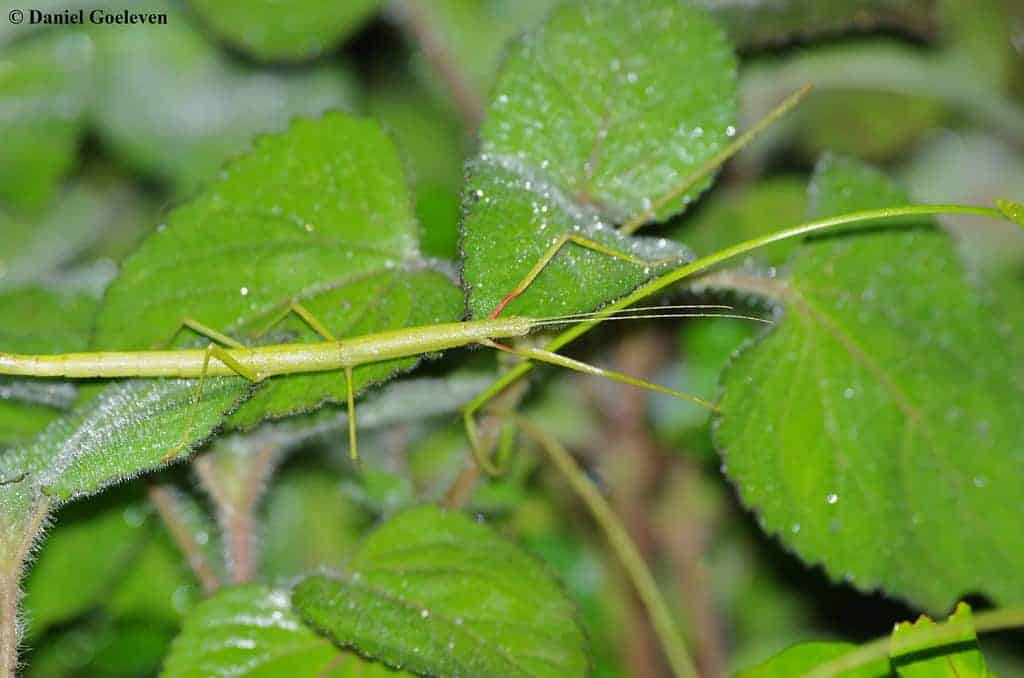
Common Indian Stick Insect (Carausius morosus)
The (common) Indian stick insect, sometimes also referred to as ‘laboratory stick insect’, is maybe the most popular and best-known stick insect of them all. And for sure is one of the easiest stick insects to be kept as pets. They don’t have many demands on the environment and climate and are easy eaters. They feed on most common plants fed to stick insects.
Although they are quite plain in colour and don’t have bizarre shapes and thorns on their body, they are still interesting to keep by their behaviour. They are easy to breed because females are parthenogenic. This species is the best one that I can recommend when you start with keeping stick insects.
Maybe you are interested to keep this stick insect species. I’ve written a comprehensive care guide for Indian stick insects that you should check out!

Zompro’s Stick Insect (Parapachymorpha zomproi)
This stick insect also has the typical thin-bodied shape with long slender legs. The colour is brown(ish) and females have some dots and very tiny thorns along their bodies. It is more rough-looking and does not have that standard plain colour.
Although it looks much more aggressive than Indian stick insects, it is a very calm species to keep. This species is particularly well for handling because it stays calm when sitting on your hand.
This species is also easy to keep, although you need to have males and females when you wish to breed with them. But when you have, you don’t have to take any additional effort.

Pink Wing Stick Insect (Sipyloidea sipylus)
As the name suggests, this stick insect has pink wings. In my opinion, this is a rather beautiful stick insect. The wings are not only beautiful in colour, but also functional. This stick insect can fly very well, and with handling be aware, that they can fly large distances.
In captivity, this species only have females and breed parthenogenetically. Keeping and breeding pink wing stick insects is rather easy and therefore makes a perfect animal to have as a pet.
Popular thick-bodied stick insects
In contrast with the previous species, the thick-bodied stick insect has, as the name suggests, a much thicker body and often shorter legs. This group of stick insects often have appendages on their body and legs that contribute to their camouflage, and therefore have strange and bizarre shapes. Many people love these more “exotic” stick insect species. We discuss the most popular species in this category.
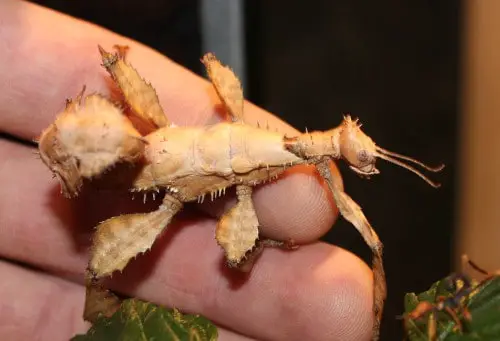
Giant Prickly Stick Insect (Extatosoma tiaratum)
After the common Indian stick insect, this is one of the most popular stick insects kept as pets. The giant prickly stick insect is rather large and heavily bodied. With the many thorn-shaped appendages, it looks dangerous, but nothing is further from the truth. This species is very docile and don’t inflict any harm to you as a keeper.
Why is this stick insect so popular then? Well, it is almost effortless to keep! Giant prickly stick insects are very sturdy and quite tolerant of different temperatures and humidity. The males have large wings and can fly, although it is quite clumsy.
Another interesting fact about this species is that it has some colour variation. The species comes from light greenish to dark brownish. Check out the care sheet about giant prickly stick insect to find out more about this amazing species.
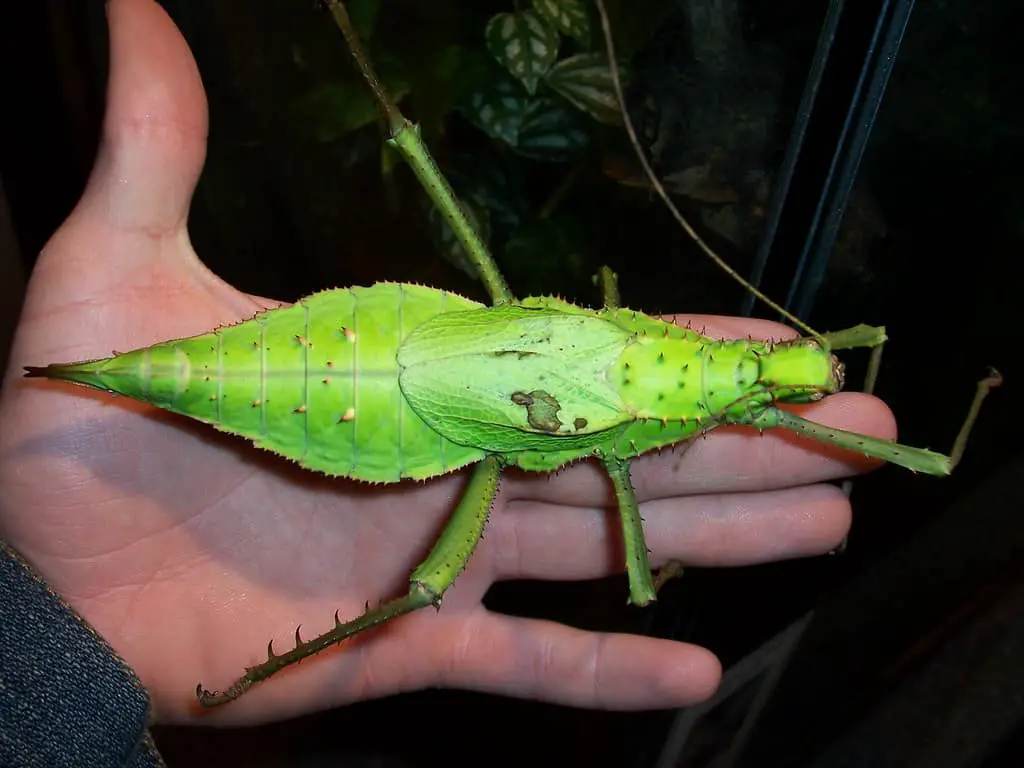
Jungle Nymph (Heteropteryx dilatata)
The name of this stick insect is somewhat misleading. Where nymph is used to describe young stick insects, this species is one of the largest and the heaviest species there is! Although it has quite large thorn-liked-shaped appendages on its body and legs, it is not dangerous at all. Actually, they tend to be quite docile and will sit still when positioned on your hand.
When you want to keep this species, you need to be aware that they need a rather large enclosure to live in. And if you wish to breed with them, you need to be patient. It can take up to 12 to 14 months before the egg will hatch. This species only reproduce sexually, so you’ll need a couple of them. Other than that they are really easy to keep and quite amazing to see!
Want to know more about jungle nymph stick insects? Check out our jungle nymph care guide.
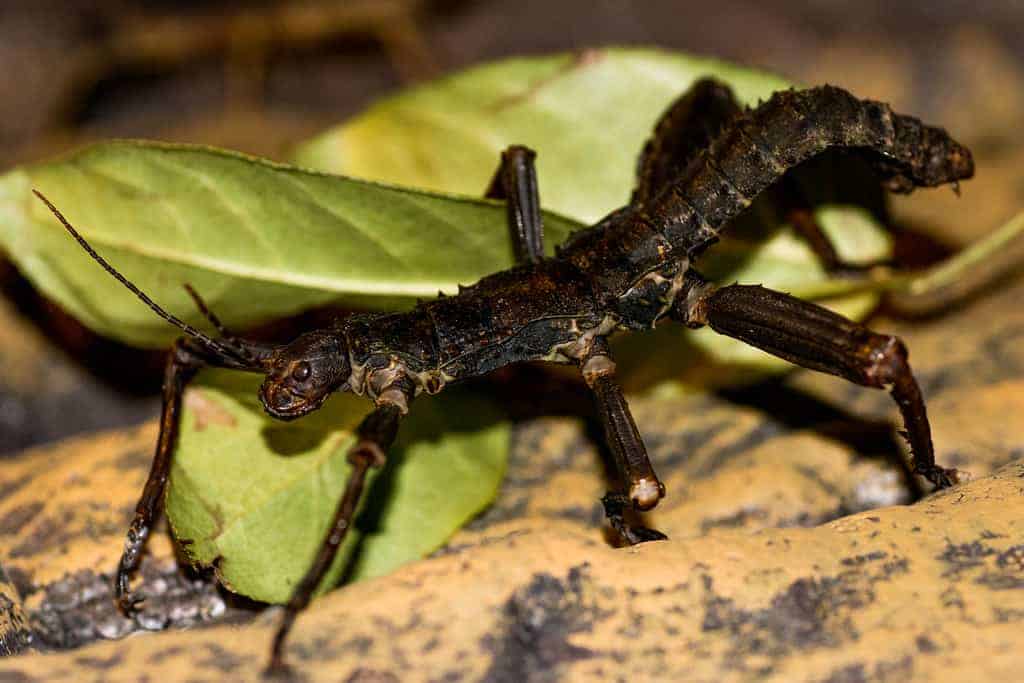
Giant Spiny Stick Insect (Eurycantha calcarata)
Typically this giant spiny stick insect (and not confusing with giant prickly stick insect) is very dark brown in colour and also quite large. This species, one of my favourites, have legs with many sharp spines. It is a quite chunky and heavy stick insect.
Although most stick insects are tree dwellers, close to their food and blend in perfectly with their camouflage, this species can often be found on the floor resting. So don’t worry when you see this natural behaviour. However, they will climb up to eat from the leaves you provide.
Popular leaf insects
Although leaf insects also have thick bodies, these type of stick insects has a body typically shaped as a leaf as part of their camouflage. It is not only the shape itself, but also the leaf nerves are imitated, and on their legs are small appendages that when folded it is hard to distinguish this stick insect from a leaf.
That is why this type of stick insect is also trendy to be kept as pets. We will discuss the most popular ones that you can regularly encounter in exotic pet shops and online stores.
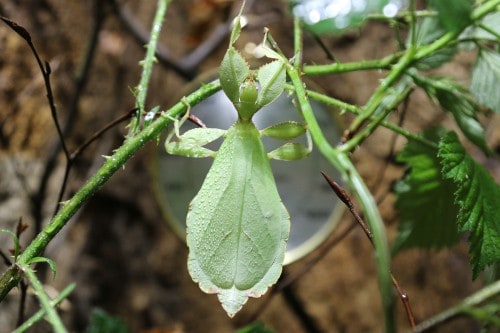
Philippine Leaf Insect (Phyllium philippinicum)
This beautiful species is a very popular stick insect kept as pets. It is regularly available at online stores. It is quite easy to keep although breeding can be a bit tough.
Obviously, these species camouflage themselves as leaves. Besides the amazing shape, it also mimics leaves by their behaviour. When feeling threatened, they will start waving like a leaf in the wind. The nymphs are dark brown with white dots and slowly turn green within the first two moulds.
You can read more about keeping and caring for Philippine leaf insects in this care sheet.
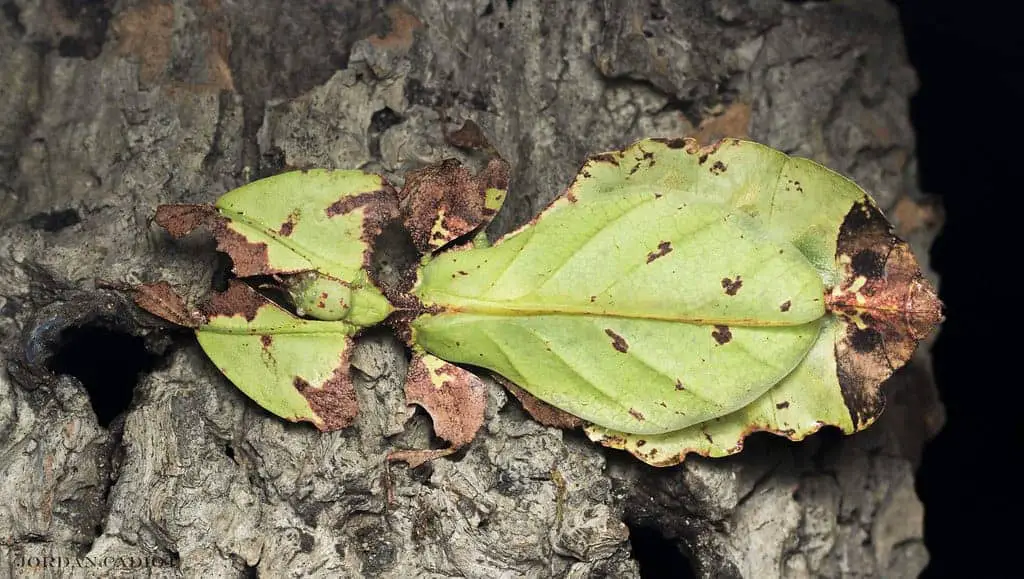
Giant Leaf Insect (Phyllium giganteum)
Another popular leaf insect kept and reared in captivity is the giant leaf insect. It is the largest leaf insect discovered today with a size of 10cm. Although popular and kept by many people, this species is a bit more difficult to keep and breed. The species is more sensitive to environmental changes, and small nymphs have sometimes trouble to start eating. So this is absolutely not a beginner’s species.
In captivity, there are only females and this species breed parthenogenic. You have to be more patient because eggs will hatch after 5 to 7 months of incubation.
Bonus: Surprising stick insects
Although most stick insects are green to brown and have shapes that camouflage them well on where they eat and live, some stick insects are surprisingly colourful. So if you want to have a stick insect that has more or different colours, check out the stick insect species below!
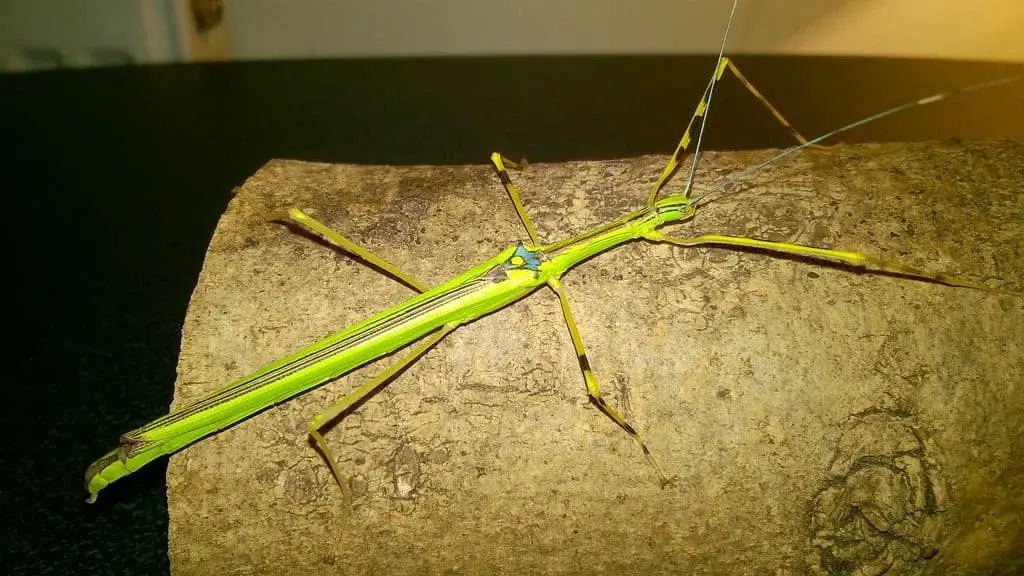
Yellow Flying Stick Insect (Necroscia annulipes)
This beautiful coloured species from Malaysia is a very popular stick insect to keep as a pet because it’s both beautiful and quite easy to take care of. Adults have wings which are light pink, and the colour pattern exists of red, green, blue, yellow and black.
This species has an elegant body shape. The legs are skinny, and also its body has a typical stick insect shape. As the name suggests, these stick insects can fly pretty good, so be careful when you are handling this species. Yellow flying stick insects are not very large, with adults generally around 7cm.

Black Beauty Stick Insect (Peruphasma schultei)
Maybe not every person thinks this is a beauty, but it certainly doesn’t look boring and as a classic stick insect at all. The black beauty stick insect has a completely thick black body with only some red around the mouthparts and rudimental wings. The eyes are bright yellow, and they have long black antennae.
This stick insect species only reproduce sexually, so you need at least a couple to breed with them. It can be relatively fast so be careful when handling this species. When you open the enclosure they like to explore their environment, so watch out they don’t escape. When they feel threatened they can excrete some irritating fluids from their body. The fluid is harmless for humans, but it is advised to wash your hands every time you touched an animal.
Want to know more?
Want to know more about keeping stick insects and leaf insects? I can recommend you to start with reading our guide about caring for stick insects.
If you like to know more about the basics of breeding stick insects, you should check out our guide on breeding phasmids.
Share this page!

